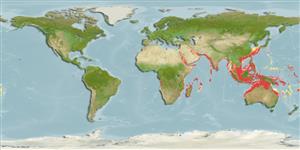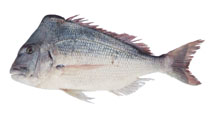Ajouter votre observation dans Fish Watcher
| Native range | All suitable habitat | Point map | Year 2050 |

|
| This map was computer-generated and has not yet been reviewed. |
| Argyrops spinifer AquaMaps Data sources: GBIF OBIS |
Envoyez vos Photos et vidéos
Pictures | Images GoogleArgyrops spinifer
Picture by Iranian Fisheries Research Organization (IFRO)
Pictures | Images GoogleArgyrops spinifer
Picture by Iranian Fisheries Research Organization (IFRO)
Kuwait country information
Common names:
Andag
Occurrence: native
Salinity: marine
Abundance: | Ref:
Importance: | Ref:
Aquaculture: | Ref:
Regulations: | Ref:
Uses: no uses
Comments: Also Ref. 2115.
National Checklist:
Country Information: https://www.cia.gov/library/publications/resources/the-world-factbook/geos/ku.html
National Fisheries Authority:
Occurrences: Occurrences Point map
Main Ref: Al-Husaini, M., J.M. Bishop, H.M. Al-Foudari and A. Al-Baz, 2015
National Database:
Occurrence: native
Salinity: marine
Abundance: | Ref:
Importance: | Ref:
Aquaculture: | Ref:
Regulations: | Ref:
Uses: no uses
Comments: Also Ref. 2115.
National Checklist:
Country Information: https://www.cia.gov/library/publications/resources/the-world-factbook/geos/ku.html
National Fisheries Authority:
Occurrences: Occurrences Point map
Main Ref: Al-Husaini, M., J.M. Bishop, H.M. Al-Foudari and A. Al-Baz, 2015
National Database:
Common names from other countries
Classification / Names Noms communs | Synonymes | Catalog of Fishes(Genre, Espèce) | ITIS | CoL | WoRMS | Cloffa
> Eupercaria/misc (Various families in series Eupercaria) > Sparidae (Porgies)
Etymology: Argyrops: Greek, argyros = silver, silvered + Gree, ops = appearance (Ref. 45335).
More on author: Forsskål.
Etymology: Argyrops: Greek, argyros = silver, silvered + Gree, ops = appearance (Ref. 45335).
More on author: Forsskål.
Environment: milieu / climate zone / depth range / distribution range Écologie
marin démersal; profondeur 1 - 450 m (Ref. 100719), usually 5 - 100 m (Ref. 30573). Tropical; 34°N - 28°S
Distribution Pays | Zones FAO | Écosystèmes | Occurrences | Point map | Introductions | Faunafri
Indian Ocean: including the Red Sea and Persian Gulf, to Singapore and southernmost end of the Malay Peninsula.
Length at first maturity / Taille / Poids / Âge
Maturity: Lm 30.9 range ? - ? cm
Max length : 80.0 cm TL mâle / non sexé; (Ref. 124569); common length : 30.0 cm TL mâle / non sexé; (Ref. 3507)
Max length : 80.0 cm TL mâle / non sexé; (Ref. 124569); common length : 30.0 cm TL mâle / non sexé; (Ref. 3507)
Description synthétique Clés d'identification | Morphologie | Morphométrie
Épines dorsales (Total) : 11 - 13; Rayons mous dorsaux (Total) : 9 - 10; Épines anales: 3; Rayons mous anaux: 7 - 8; Vertèbres: 24. This species is distinguished from all its congeners by the following set of characters: body deep and becoming compressed and less deep with growth; D XII,10, the first 2 dorsal-fin spines rudimentary (2 dorsal-fin spines on first dorsal pterygiophore); the dorsal-fin with two morpho types of configuration (Type I 'rigid type', fragile] as a rigid tapering spine and Type II ['flexible type', comparatively robust] as a flexible tapering spine in Group A - Red Sea, Group B - Gulf of Aden and eastern coast of Africa, and Group C - Persian Gulf, only Type II, is seen in both Group D - Madagascar to Sri Lanka and Group E - Eastern Indian Ocean, each Group is allopatric and is likely to have similar genetic structure (not analyzed in Group D or E). Colouration: body uniform pink with belly and lower jaw silvery, head red; spinous dorsal fin pink or red, other fins pink or pale pink; with pink tinge around eye; upper jaw often pinkish; anterior and posterior margins of the upper cheek scales nearly parallel just below rear edge of eye; orbit diameter is clearly less than suborbital depth (Ref. 124569).
Found in a wide range of bottoms. Young fish occur in very shallow waters of sheltered bays; larger individuals in deeper water. Feed on benthic invertebrates, mainly mollusks (Ref. 5213). Important food fish.
Life cycle and mating behavior Maturité | Reproduction | Frai | Œufs | Fécondité | Larves
Référence principale
Upload your references | Références | Coordinateur | Collaborateurs
Iwatsuki, Y. and P.C. Heemstra, 2018. Taxonomic review of the genus Argyrops (Perciformes; Sparidae) with three new species from the Indo-West Pacific. Zootaxa 4438(3):401-442. (Ref. 124569)
Statut dans la liste rouge de l'IUCN (Ref. 130435: Version 2024-2)
Préoccupation mineure (LC) ; Date assessed: 02 December 2009
Menace pour l'homme
Harmless
Utilisations par l'homme
Pêcheries: commercial
FAO(pêcheries: production; publication : search) | FishSource | Sea Around Us
Plus d'informations
Trophic ecology
Éléments du régime alimentaire
Composition du régime alimentaire
Consommation alimentaire
Food rations
Prédateurs
Éléments du régime alimentaire
Composition du régime alimentaire
Consommation alimentaire
Food rations
Prédateurs
Population dynamics
Paramètres de croissance
Max. ages / sizes
Length-weight rel.
Length-length rel.
Fréquences de longueurs
Mass conversion
Recrutement
Abondance
Paramètres de croissance
Max. ages / sizes
Length-weight rel.
Length-length rel.
Fréquences de longueurs
Mass conversion
Recrutement
Abondance
Physiology
Body composition
Nutrients
Consommation d'oxygène
Type de nage
Vitesse de nage
Visual pigments
Fish sound
Diseases & Parasites
Toxicity (LC50s)
Body composition
Nutrients
Consommation d'oxygène
Type de nage
Vitesse de nage
Visual pigments
Fish sound
Diseases & Parasites
Toxicity (LC50s)
Genetics
Génétique
Heterozygosity
Héritabilité
Génétique
Heterozygosity
Héritabilité
Human related
Aquaculture systems
Profils d'aquaculture
Souches
Ciguatera cases
Stamps, coins, misc.
Aquaculture systems
Profils d'aquaculture
Souches
Ciguatera cases
Stamps, coins, misc.
Outils
E-book | Guide de terrain | Clés d'identification | Générateur de fréquences de longueur | Outil de dynamique de population | Carte par point | Classification Tree
| Catch-MSY |
Articles particuliers
Télécharger en XML
Sources Internet
Aquatic Commons | BHL | Cloffa | BOLDSystems | Websites from users | FishWatcher | CISTI | Catalog of Fishes(Genre, Espèce) | DiscoverLife | ECOTOX | Faunafri | Fishtrace | GenBank(génôme, nucléotide) | GloBI | GOBASE | | Google Books | Google Scholar | Google | IGFA World Record | MitoFish | Bases de données nationales | Otolith Atlas of Taiwan Fishes | PubMed | Reef Life Survey | Scirus | SeaLifeBase | Arbre de Vie | Wikipedia(aller à, chercher) | World Records Freshwater Fishing | Zoological Record
Estimates based on models
Preferred temperature (Ref. 115969): 23.4 - 29, mean 27.9 (based on 3786 cells).
Phylogenetic diversity index (Ref. 82804): PD50 = 0.5625 [Uniqueness, from 0.5 = low to 2.0 = high].
Bayesian length-weight: a=0.02291 (0.01944 - 0.02700), b=2.96 (2.91 - 3.01), in cm Total Length, based on LWR estimates for this species (Ref. 93245).
Niveau trophique (Ref. 69278): 3.7 ±0.38 se; based on food items.
Résilience (Ref. 120179): Faible, temps minimum de doublement de population : 4,5 à 14 années (K=0.08-0.21; tmax=25; tm=2; Fec = 47,000).
Fishing Vulnerability (Ref. 59153): High vulnerability (55 of 100).
Climate Vulnerability (Ref. 125649): High vulnerability (61 of 100).




